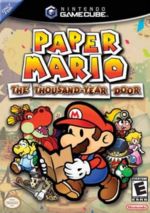Difference between revisions of "Paper Mario: The Thousand-Year Door"
m |
WarioFan63 (talk | contribs) |
||
| Line 32: | Line 32: | ||
It was followed by ''[[Super Paper Mario]]'' for the [[Nintendo Wii]], which took on a new gameplay style. | It was followed by ''[[Super Paper Mario]]'' for the [[Nintendo Wii]], which took on a new gameplay style. | ||
| − | [[Category: | + | [[Category: GameCube Games]] |
[[Category: Mario Games]] | [[Category: Mario Games]] | ||
[[Category: Player's Choice]] | [[Category: Player's Choice]] | ||
Revision as of 19:22, 6 January 2010

| |
| Paper Mario: The Thousand-Year Door | |
| Developer | Intelligent Systems |
| Publisher | Nintendo |
| System | Nintendo Gamecube |
| Release Date | JP July 22, 2004 US October 11, 2004 EU November 12, 2004 |
| Gallery | GH Gallery |
| Rating | ESRB: E |
The sequel to Paper Mario on the Nintendo 64, this game features much of the same sort of thing. Mario and his partners go on an adventure to rescue Princess Peach.
Story
On vacation in Rogueport, Princess Peach is given a chest that can only be opened by the pure of heart by a merchant. Peach is able to open it and finds a map inside. She sends it to Mario who hurries to Rogueport.
When Mario arrives at Rogueport, he sees a young Goomba being harassed. After saving her, she tells him that she's a student of archeology. They show the map to her professor who tells them that it shows the location of the seven crystal stars. Mario decides to find the stars in hopes of finding Peach on the way.
Gameplay
The battle system is different than most RPGs because it's action-oriented. Pressing the "A" button at the right time will increase the damage your character does or decrease the damage you enemies do. Special attacks require you to press certain buttons as well.
New to Paper Mario: The Thousand-Year Door is the audience. In every battle, people watch and they will sometimes throw items on stage. They also determine how quickly your Star Power recharges.
Also interesting is Mario's ability to transform into different things, which he learns at different points in the game. For example, Mario can cross long pits by turning into a paper airplane.
Sequels
It was followed by Super Paper Mario for the Nintendo Wii, which took on a new gameplay style.